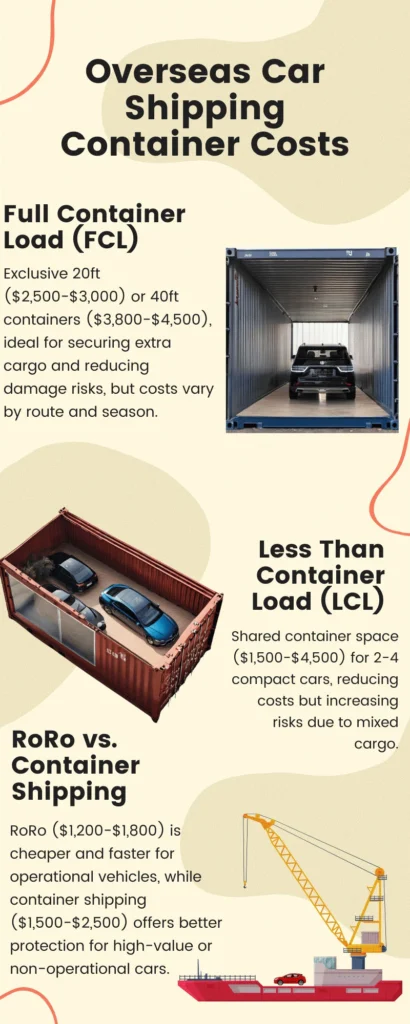Container Car Shipping Costs Discussed With Examples
Did you know that over 8 million cars are shipped in containers annually? This staggering statistic highlights the growing popularity of container shipping for overseas vehicle transport.

Overseas Car Shipping Container Costs:
Full Container Load (FCL):
When it comes to shipping a car in a full container, you have the option of choosing between a 20ft or 40ft container.
| Container Size | Shipping Cost from Los Angeles to Shanghai | Shipping Cost from New York to London |
| 20ft Container | $2,500 | $3,000 |
| 40ft Container | $3,800 | $4,500 |
As you can see, the 40ft container generally costs more than the 20ft container, as it provides more space for your vehicle and any additional cargo. However, the shipping costs can vary depending on the route, the time of year, and other factors.
Less Than Container Load (LCL):
LCL shipping allows you to consolidate your vehicle with other cargo, sharing the container space and associated costs. This approach can be particularly advantageous for shipping smaller cars or moving just a single vehicle abroad.
| Container Size | Maximum Car Capacity | Estimated LCL Shipping Cost |
| 20ft LCL | 2 compact cars | $1,500 – $3,000 |
| 40ft LCL | 4 compact cars | $1,000 – $4,500 |
RoRo vs Cars in Container Shipping Cost Differences:
For shipping a mid-size sedan from the United States to Japan, RoRo car shipping may cost around $1,200, while container car shipping could cost $1,500 to $2,500. However, for larger vehicles like SUVs or pickup trucks, the cost gap between RoRo and container shipping may narrow, with RoRo costing approximately $1,500 and container shipping around $2,200.
| Vehicle Type | RoRo Shipping Cost | Car Container Shipping Costs |
| Mid-size Sedan | $1,500 | $2,000 – $2,500 |
| SUV/Pickup Truck | $1,800 | $2,200 |
For instance, shipping a car to Europe may have a smaller cost gap, with RoRo around $1,800 and container shipping approximately $2,000. In contrast, shipping to Australia could see a more pronounced difference, with RoRo costing $2,000 and container shipping reaching $2,500 or more.
- RoRo car shipping is generally more cost-effective for smaller and lighter vehicles.
- Container shipping may be a better option for larger or specialized vehicles, as it offers more protection during transit.
- The cost differences can also be influenced by the destination country and its port fees or other logistical considerations.
Which is better, Car in a Shipping Container or RoRo?
Pros and Cons of Container Car Shipping
| Pros | Cons |
| Enhanced protection for your vehicle | Generally more expensive than RoRo |
| Flexibility to ship personal items | Longer transit times due to container loading and unloading |
| Customizable shipping schedules | Limited space within the container |
Pros and Cons of RoRo Car Shipping
| Pros | Cons |
| Lower shipping costs compared to container shipping | Less flexibility in terms of shipping personal belongings |
| Faster transit times due to the ease of loading and unloading | Increased risk of weather-related or other external damage to the vehicle |
| Easier process for loading and unloading |
Which Type of Vehicle Should Get Closed Container Car Shipping?
Certain vehicle types and models may require the specialized protection of a closed container to ensure their safe arrival at the destination.
Luxury and high-end vehicles, such as Bentleys, Ferraris, and Lamborghinis, are prime candidates to ship container car transportation.
- In addition to luxury vehicles, classic and antique cars such as the Porsche 911, Ferrari 250 GTO, and Jaguar E-type are also well-suited for container shipping and car transport.
- Exotic and collector vehicles, such as rare sports cars like Ferrari SF90, Lamborghini Revuelto, and McLaren 750S) or limited-edition models like Mercedes-AMG Project One or BMW Nazca C2, also benefit greatly from closed container car shipping.
- Lastly, expensive motorcycles such as Harley Davidson, Ducati, Royal Enfield, and Kawasaki are well-suited vehicles for shipping container car transport.
The enclosed environment of a closed container shields these vehicles from the elements, road debris, and other hazards that could compromise their appearance or performance.
